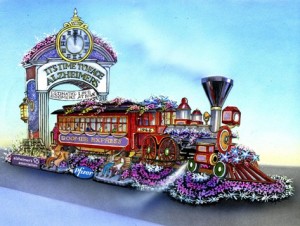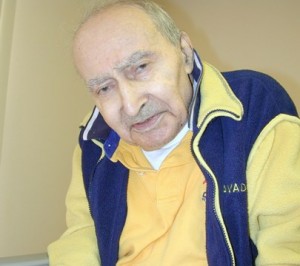With as many as 10 million U.S. baby boomers at risk for developing Alzheimer’s¹, the Alzheimer’s Association® and Pfizer are collaborating to raise awareness and reduce the stigma associated with the disease.
The Alzheimer’s Association and Pfizer have teamed up to launch the national initiative It’s Time to Face Alzheimer’s. The initiative asks Americans to voice their support about the need to address this devastating disease, and to share photos and stories of their loved ones who are, or have been, affected via the interactive website at TimetoFaceAlz.org. The photos will make up a Faces of Alzheimer’s mosaic. See my story below–Fab Dancer tries to Find Familiarity in the Foreign Land of Alzheimer’s.
 The initiative will also be featured with a float – “The Boomer Express” – in the Tournament of Roses® Parade on New Year’s Day in Pasadena, CA. “The Boomer Express” is a 55-foot long train that will ring its bell every 70 seconds to represent how frequently someone in America develops Alzheimer’s disease.¹
The initiative will also be featured with a float – “The Boomer Express” – in the Tournament of Roses® Parade on New Year’s Day in Pasadena, CA. “The Boomer Express” is a 55-foot long train that will ring its bell every 70 seconds to represent how frequently someone in America develops Alzheimer’s disease.¹
For the estimated 5.3 million Americans who are living with this disease,¹ and the 7.7 million Americans aged 65 and older who are estimated to be diagnosed with Alzheimer’s by 2030,² imagine the poignancy of hearing that bell every minute and ten seconds. You’ll feel the the urgency when you realize:
The next bell could be for my loved one.
The bell after that could be for me!
 For more information or to add your story and photo, visit the website at TimetoFaceAlz.org
For more information or to add your story and photo, visit the website at TimetoFaceAlz.org
I submitted, Fab Dancer Finding Familiarity in a Foreign Land to the Time to Face Alzheimer’s site. You may read it below:
Fab Dancer tries to Find Familiarity in the Foreign Land of Alzheimer’s
My father, Martin Avadian, was surprised when his forty-ninth birthday present was delivered in August—ME!
Throughout my childhood, we were known as the two Leos. Despite his age, he was in great shape. The last honest-to-goodness race we ran, he still won at age eighty.
Imagine that!
By eighty-six and three years since my mother died, he was struggling to make sense of his world—locking himself out of his Wisconsin home of forty-five years; pulling on the shoulder of the expressway then, disoriented, walking toward Illinois to visit his (now late) brother with Parkinson’s; forgetting to pay his bills, including his house insurance. (I discovered a major gas leak in his home that took five men from the gas company to fix.)
By the time my husband and I moved him into our California home, he was diagnosed with Alzheimer’s.
While here, he served as a fabulous dance partner with the younger ladies at the adult day care center.
We lovingly cared for him until the sleepless burden grew so great, my husband and I began showing signs of Alzheimer’s—running into the garage door and hallucinating. There’s actually a name for this—caregiver dementia.
After placing him in a local care home, he thrived while we regained our strength and spent time with him on outings, playing games, and more.
I included a picture of him that shows how Alzheimer’s steals the very essence of our loved ones; leaving a hollowed person trying to find familiarity in a foreign land.
REFERENCES
¹ Alzheimer’s Association. “2010 Alzheimer’s disease facts and figures.” Alzheimers Dement. 2010; 6:158, 161.
² Hebert, LE; Scherr, PA; Bienias, JL; Bennett, DA; and Evans, DA. “Alzheimer’s disease in the U.S. population: Prevalence estimates using the 2000 census.” Archives of Neurology 2003; 60:1119–1122.
RELATED LINKS
http://www.pfizer.com
http://www.alz.org









